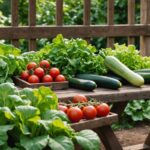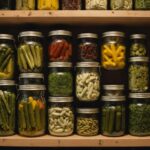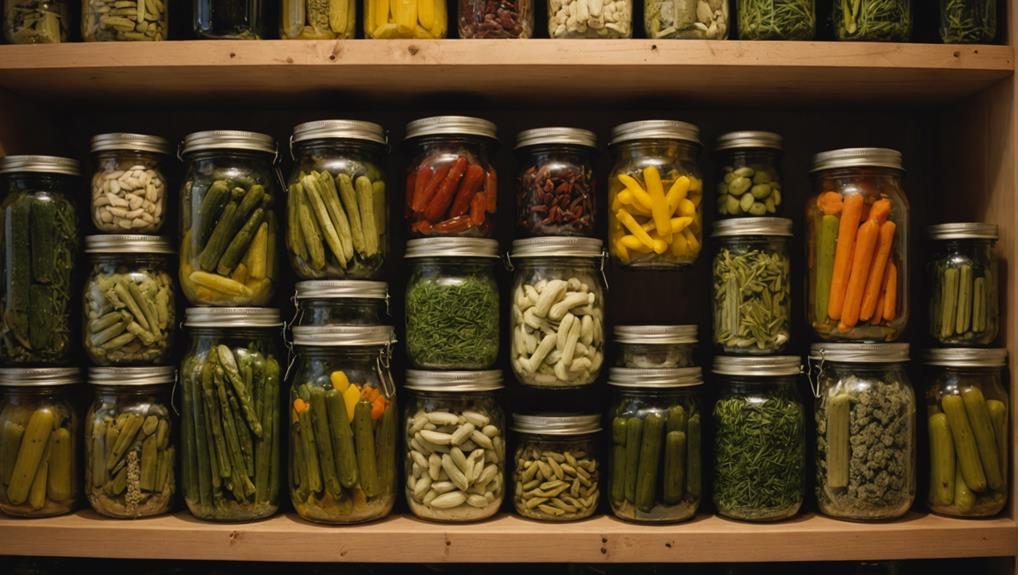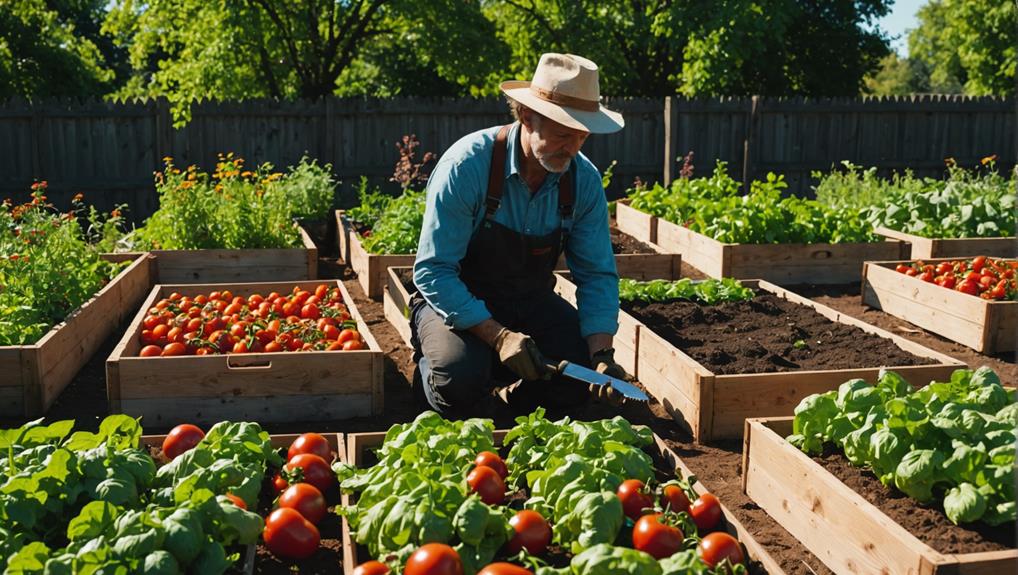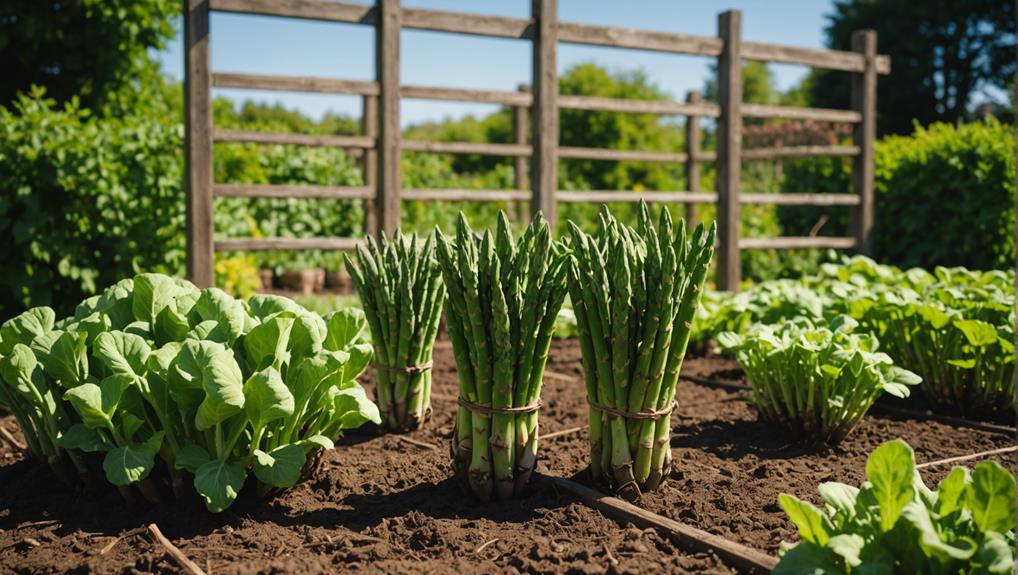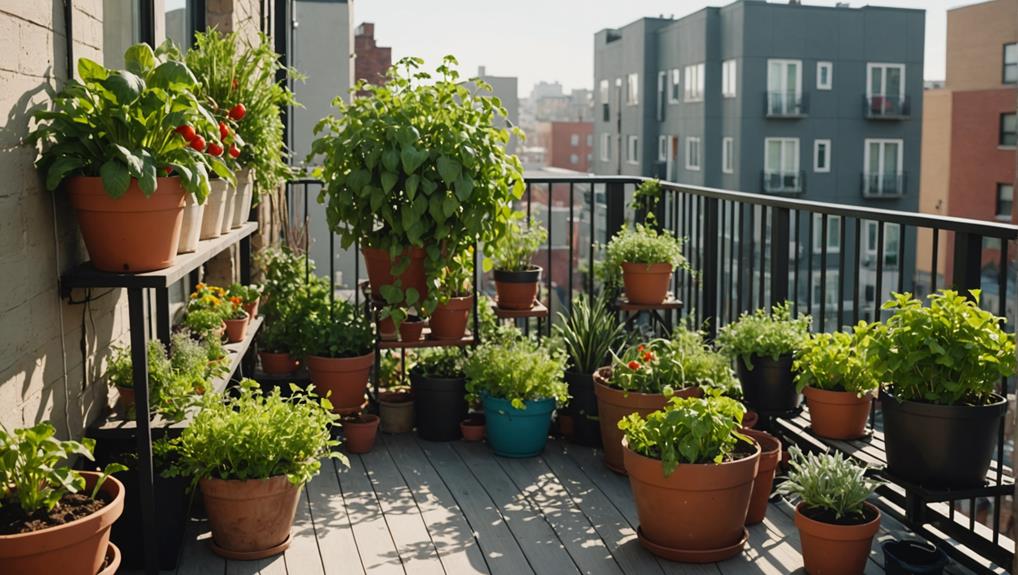As an Amazon Associate I earn from qualifying purchases.
To extend the shelf life of your food stockpile, focus on proper storage and rotation techniques. Use the FIFO method—place older items at the front and newer items at the back. Regularly check expiration dates and inspect for spoilage signs, like off odors or textures. Store foods in airtight containers in a cool, dry place to prevent spoilage. Don't forget to have a variety of foods, including canned goods and dry staples, to guarantee nutrition and longevity. With these tips, you'll optimize your stockpile's lifespan, and there's more to discover about keeping your food fresh and safe.
Importance of Food Rotation
Food rotation is essential for ensuring your emergency supplies stay fresh and nutritious. By regularly practicing food rotation, you can prevent spoilage and maintain the quality of your stockpile. Keeping track of expiration dates is vital in this process; it helps you identify which items need to be used first. Instead of letting your emergency food supply languish, make it a habit to inspect your food storage every six months.
Proper organization plays a significant role in effective food rotation. Labeling items with their purchase dates allows you to see at a glance which foods are nearing expiration. Position older items at the front and newer ones at the back to maximize accessibility. This simple strategy makes it easier to grab what you need without digging through your supplies.
Implementing FIFO Method
Implementing the FIFO method in your food storage not only helps minimize waste but also assures you enjoy the freshest items first. By placing newly purchased food items at the back of your shelves, you guarantee that older items are used first, keeping your stockpile safe and nutritious. This practical approach to food management aligns perfectly with your desire for freedom and efficiency.
To make the FIFO method work, start by labeling your food items with purchase dates. This way, you can easily track freshness and consumption before expiration dates hit. Organizing your storage area to maximize space and accessibility is essential; using stackable bins or adjustable shelves lets you see older items that need priority.
Regularly checking your stockpile and discarding expired items every six months is crucial for food safety. Following these storage guidelines not only enhances your culinary experience but also promotes a sense of security and control over your food resources. Embrace the FIFO method, and you'll find that enjoying fresh, safe food becomes an effortless part of your routine.
Checking Expiration Dates
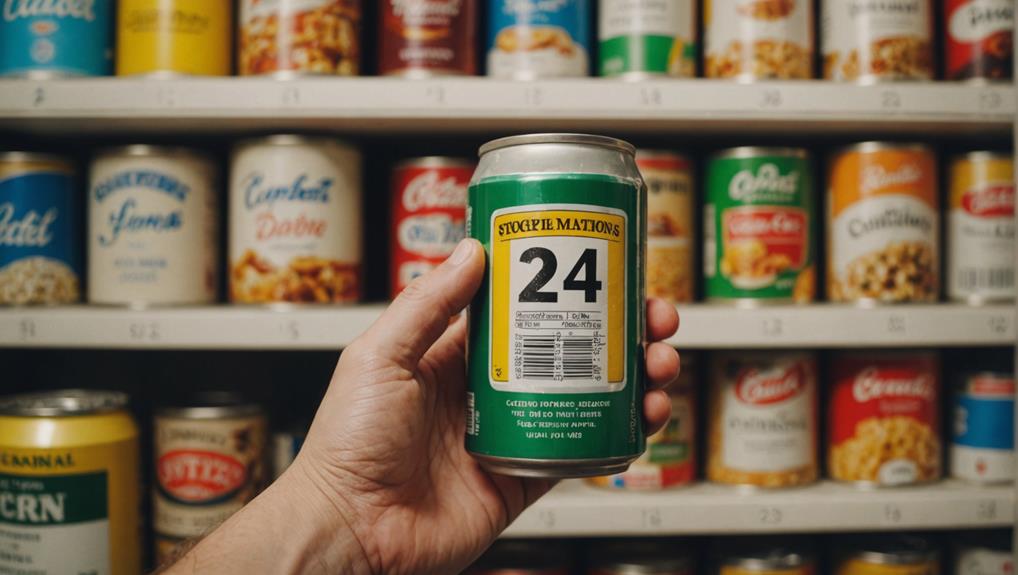
Regularly checking expiration dates helps guarantee that you consume fresh items and maintain food safety in your kitchen. By taking a proactive approach, you can keep expired food out of your stockpile, ensuring everything remains nutritious and safe. Make it a habit to inspect your food stockpile every six months. This way, you can identify and discard items that have crossed their expiration date or show signs of spoilage.
| Item | Expiration Date |
|---|---|
| Canned Beans | Jan 2024 |
| Pasta | Mar 2025 |
| Rice | Dec 2023 |
| Cereal | Feb 2024 |
| Olive Oil | Aug 2023 |
When checking expiration, don't just rely on dates. Trust your senses—discard any items with off odors, flavors, or textures. If you find near-expired items, move them to your kitchen for immediate use. This helps minimize waste and encourages consumption of older stock. Remember, replacing expired items with fresh stock keeps your emergency food supply reliable and nutritious. Stay vigilant, and enjoy the freedom of a well-stocked, safe kitchen!
Proper Food Storage Techniques
To guarantee your groceries stay fresh and safe, apply proper food storage techniques that protect against spoilage and maintain quality. First, store food in a cool, dry environment, ideally between 50°F to 70°F, away from sunlight. Your kitchen cabinets can be a great option if you keep them organized.
For dry goods, use air-tight containers to shield against moisture and bacteria, greatly extending their shelf life. If you're looking to store long-term food, consider mylar bags with oxygen absorbers, which enhance storage stability and prevent oxidation.
Elevating your food storage off the ground not only reduces moisture exposure but also deters pests, ensuring a cleaner environment for your stockpile. When you're storing items like meats or produce, don't hesitate to store in the freezer. Vacuum-sealing items in mason jars is another excellent technique for ideal long-term storage. This method preserves flavors and nutrients while preventing freezer burn.
Variety of Foods for Emergencies
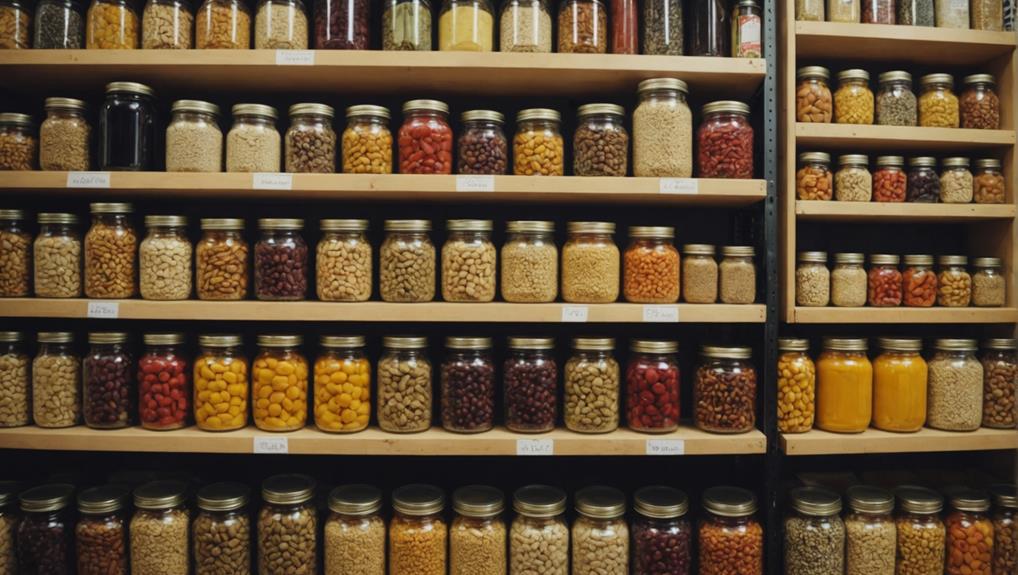
When planning for emergencies, you need a variety of foods to guarantee nutritional balance and long shelf life. Stocking up on canned goods, dry foods, and freeze-dried meals can help you stay prepared. Remember, having a diverse selection not only meets your dietary needs but also keeps your spirits up during tough times.
Essential Emergency Food Types
A well-rounded emergency food stockpile includes a variety of essential items, ensuring you have the nutrients and energy needed to weather any crisis. Start with canned goods like vegetables, fruits, meats, and soups. These provide crucial nutrients and can be stored easily. Keep them in a dry place to maintain their quality.
Next, add dry foods such as rice, pasta, beans, and lentils. Their long shelf life and versatility make them staples in your emergency preparedness plan. Freeze-dried meals are another excellent choice; they're lightweight and last longer, perfect for situations where space is tight.
Don't overlook non-perishable snacks, either. Granola bars, nuts, and dried fruits can give you quick energy boosts and help keep morale high during tough times. By stocking a diverse range of food, you're not only extending your options but also ensuring that you can sustain your health and well-being throughout any extended emergency.
Nutritional Balance Importance
Maintaining nutritional balance during emergencies relies on having a variety of foods that provide different essential nutrients. When you stock up on emergency foods, consider including common foods like canned vegetables, fruits, meats, and soups. This guarantees you get a balanced intake of necessary vitamins and minerals. Don't overlook dry foods such as rice, pasta, beans, and lentils; they're rich in carbohydrates and proteins, vital for sustaining your energy levels.
Freeze-dried meals are a fantastic addition, offering long storage dates while retaining their nutritional value. You'll appreciate the lightweight options they provide, making them easy to handle in tough situations. Non-perishable snacks like granola bars, nuts, and dried fruits not only add dietary diversity but also help you meet your daily caloric needs.
Long Shelf Life Options
Stockpiling a diverse range of long shelf life foods guarantees you're prepared for emergencies while meeting your nutritional needs. Start with canned goods, including high-acid options like tomatoes and low-acid choices such as vegetables and meats, which can last from 1.5 to 5 years. Don't forget dry staples like rice, pasta, beans, and lentils; white rice can last indefinitely, while brown rice lasts about six months.
Freeze-dried meals also stand out, providing a lightweight option with a remarkable shelf life of 25 to 30 years when stored correctly. For quick energy boosts, include non-perishable snacks like granola bars, nuts, and dried fruits in your stockpile. These items not only taste great but also have long shelf lives, making them perfect for emergencies.
As you build your stockpile, verify you maintain a balanced diet by including a variety of foods that offer essential nutrients, including vitamins, minerals, and protein supplements. This approach helps you stay nourished and ready, regardless of what expiration dates may say. Embrace the freedom to be self-sufficient by planning ahead with an all-encompassing selection of long shelf life foods.
Food Quality and Shelf Life
To keep your food fresh and safe, proper storage is key. You should also be aware of signs of spoilage, like off smells or unusual textures, to avoid consuming bad food. Understanding these factors will help you maintain quality and extend the shelf life of your pantry staples.
Importance of Proper Storage
How you store food can greatly impact its quality and shelf life, making proper storage practices vital for your kitchen. By maintaining the right conditions, like keeping your kitchen cabinets between 50°F to 70°F and your refrigerator at 37°F, you can greatly extend the life of your foods. Using airtight containers for dry goods, such as flour, prevents moisture and bacteria from ruining your stock, allowing it to last up to two years in the fridge.
When it comes to canned foods, low-acid varieties like vegetables and meats can last up to five years in a cool, dark place, while high-acid options should be consumed within 1.5 years for best quality. Freezing is another option that can preserve food safety indefinitely, although you should seal items properly to avoid freezer burn and maintain flavor.
Regularly check your food containers for spoilage, and follow best storage practices to guarantee you're maximizing the nutritional value of your stock. By understanding how expiration dates work and focusing on food safety, you'll enjoy the freedom of having quality ingredients on hand whenever you need them.
Signs of Spoilage Awareness
Recognizing signs of spoilage is vital for guaranteeing the safety and quality of the food you consume. No matter what the expiration date says, off odors, flavors, or textures signal that your food might not be safe to eat. Always trust your senses; if something seems off, it likely is.
When you buy commercially canned foods, check for bulging, rusting, or severe dents. These signs can compromise the seal and lead to contamination. High-acid canned goods like tomatoes can last about 1.5 years, while low-acid options, such as meats and veggies, can remain safe for up to 5 years if stored properly.
For foods like dried beans and grains, don't get too caught up in the expiration date—just look for any visible signs of spoilage. Routine inspection of your food containers is important. If you spot any damage or signs of spoilage, it's best to toss them out. Stay vigilant and prioritize your health by regularly checking your stockpile to make sure you're only consuming fresh foods. Remember, your safety should always come first!
Safety and Quality After Expiration
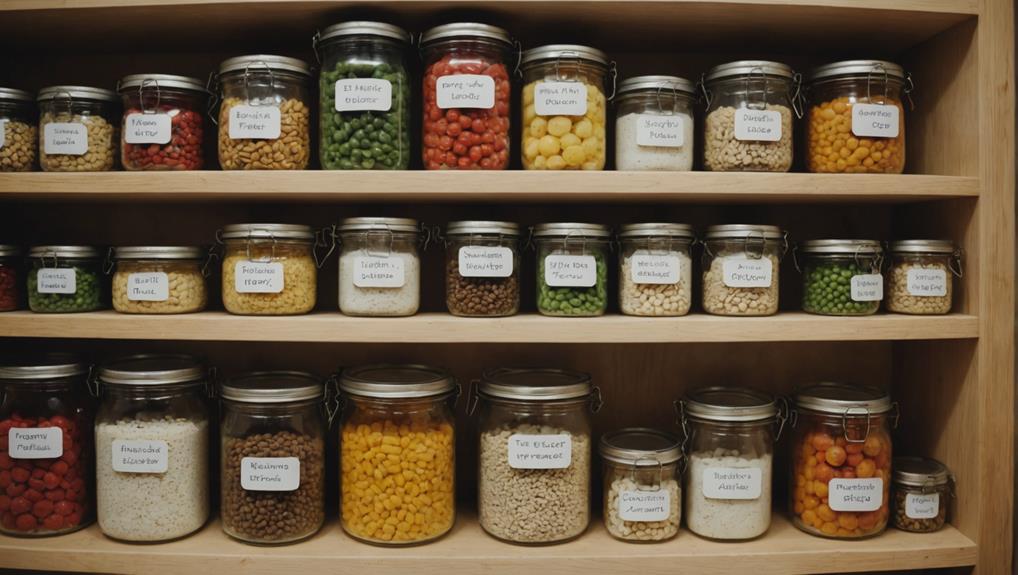
Evaluating food for safety and quality after its expiration date can prevent unnecessary waste and guarantee you're making informed choices about what to eat. Many foods remain safe to consume well past their expiration dates, as long as you inspect them for signs of spoilage like off odors, flavors, or textures. This gives you the freedom to enjoy your stockpile without the fear of wasting perfectly good food.
However, be cautious with infant formula; it must be consumed by its expiration date to maintain safety. For other items, proper storage can extend their lifespan considerably. High-acid canned foods, like tomatoes, can last up to 1.5 years, while low-acid foods, such as vegetables and meats, can last up to 5 years when stored correctly.
Frozen foods are safe indefinitely, but keep in mind that their quality might decline due to changes in texture and flavor. To maintain quality, make sure to seal them properly to prevent freezer burn. Being vigilant about food safety and quality can empower you to make the most of your stockpile.
Shelf Life of Canned and Frozen Foods
Canned and frozen foods can offer a long shelf life, making them convenient options for your pantry and freezer. When it comes to canned foods, high-acid items like tomatoes and citrus usually last about 1.5 years. In contrast, low-acid foods such as vegetables, meats, and fish can last up to 5 years if you store them properly. Always keep your canned goods in a dark, cool place and toss any cans that are bulging, rusted, or dented to guarantee food safety.
Frozen foods are a bit different—they remain safe indefinitely. However, their quality can decline over time, particularly regarding texture and flavor. To maintain that quality, seal your frozen items tightly and label them with the freezing date. This way, you can keep track of their shelf life. Remember, while bacteria can survive freezing, proper handling after thawing is crucial for maintaining food safety. By following these guidelines, you can enjoy the freedom and convenience of canned and frozen foods without compromising on quality or safety.
Guidelines for Leftovers
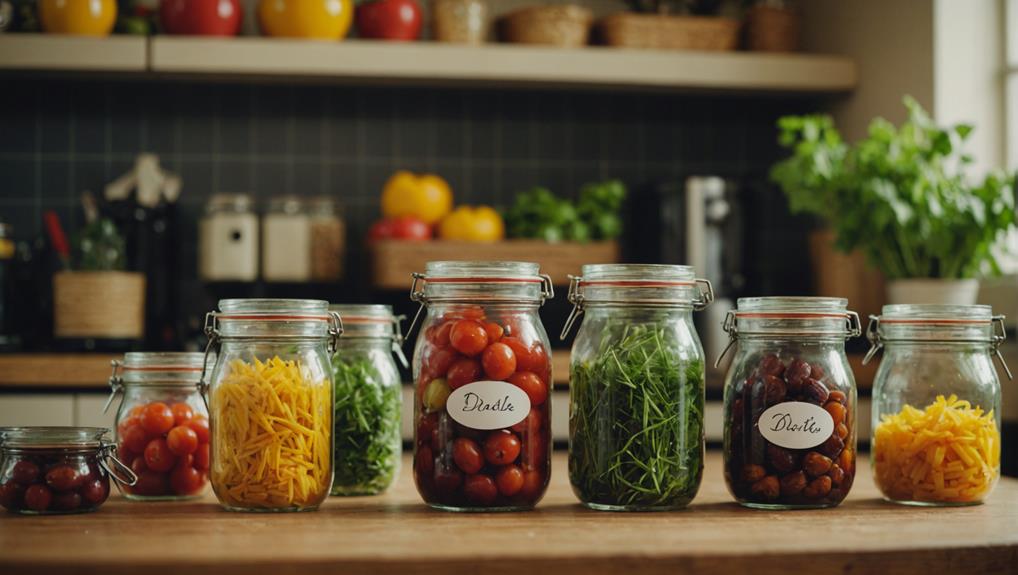
Storing leftovers properly is essential for keeping your meals safe and delicious. To guarantee food safety, you should consume refrigerated leftovers within 3-4 days. Be especially cautious with seafood and mayonnaise-based dishes, as they have shorter expiration dates. Remember, don't leave cooked food at room temperature for more than 2 hours to prevent bacteria growth, particularly in warmer conditions.
To cool large dishes quickly and evenly, transfer them into smaller, shallow containers before placing them in the fridge. This simple step can help minimize the risk of foodborne illnesses. If you decide to freeze your leftovers, aim to enjoy them within 3-4 months for the best quality and taste. However, they can remain safe beyond this time frame, so don't fret if you find something stashed away.
For best results, store frozen leftovers in airtight containers to prevent flavor absorption from other foods. Make it a habit to label them with the date of freezing, so you can keep track of when to use them. By following these guidelines, you'll make the most of your leftovers while keeping food safety at the forefront.
Frequently Asked Questions
How to Prolong the Shelf Life of Food?
To prolong your food's shelf life, embrace food preservation techniques like vacuum sealing, explore freezing methods, and try dehydrating foods. These strategies empower you to enjoy your stockpile longer, reducing waste and enhancing freedom.
How Can I Increase My Food Expiry Date?
To increase your food expiry dates, employ food preservation techniques like vacuum sealing and freezing methods. Embrace best storage practices, and you'll enjoy longer-lasting freshness and freedom from worrying about spoilage.
What Is Added to Food to Extend Shelf Life?
To extend shelf life, you'll find preservative types like nitrates, natural alternatives such as vinegar, effective packaging techniques like MAP, and ideal storage conditions all play essential roles in keeping your food fresh longer.
How Do You Increase the Shelf Life of Canned Food?
To increase your canned food's shelf life, store it in ideal temperatures, control moisture, and consider vacuum sealing for opened cans. Proper canned food storage keeps your stockpile fresh and ready for when you need it.
Conclusion
By following these tips, you can effectively extend the shelf life of your stockpile and guarantee your food stays safe and tasty. Remember to rotate your supplies using the FIFO method and check expiration dates regularly. Proper storage techniques are essential, and don't forget to include a variety of foods in your stockpile. With these strategies, you can enjoy peace of mind knowing your emergency supplies are ready when you need them most!
As an Amazon Associate I earn from qualifying purchases.




